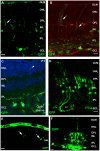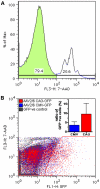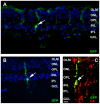GFAP-driven GFP expression in activated mouse Müller glial cells aligning retinal blood vessels following intravitreal injection of AAV2/6 vectors
- PMID: 20808778
- PMCID: PMC2927518
- DOI: 10.1371/journal.pone.0012387
GFAP-driven GFP expression in activated mouse Müller glial cells aligning retinal blood vessels following intravitreal injection of AAV2/6 vectors
Abstract
Background: Müller cell gliosis occurs in various retinal pathologies regardless of the underlying cellular defect. Because activated Müller glial cells span the entire retina and align areas of injury, they are ideal targets for therapeutic strategies, including gene therapy.
Methodology/principal findings: We used adeno-associated viral AAV2/6 vectors to transduce mouse retinas. The transduction pattern of AAV2/6 was investigated by studying expression of the green fluorescent protein (GFP) transgene using scanning-laser ophthalmoscopy and immuno-histochemistry. AAV2/6 vectors transduced mouse Müller glial cells aligning the retinal blood vessels. However, the transduction capacity was hindered by the inner limiting membrane (ILM) and besides Müller glial cells, several other inner retinal cell types were transduced. To obtain Müller glial cell-specific transgene expression, the cytomegalovirus (CMV) promoter was replaced by the glial fibrillary acidic protein (GFAP) promoter. Specificity and activation of the GFAP promoter was tested in a mouse model for retinal gliosis. Mice deficient for Crumbs homologue 1 (CRB1) develop gliosis after light exposure. Light exposure of Crb1(-/-) retinas transduced with AAV2/6-GFAP-GFP induced GFP expression restricted to activated Müller glial cells aligning retinal blood vessels.
Conclusions/significance: Our experiments indicate that AAV2 vectors carrying the GFAP promoter are a promising tool for specific expression of transgenes in activated glial cells.
Conflict of interest statement
Figures








References
-
- Bringmann A, Pannicke T, Grosche J, Francke M, Wiedemann P, et al. Muller cells in the healthy and diseased retina. Prog Retin Eye Res. 2006;25:397–424. - PubMed
-
- Dyer MA, Cepko CL. Control of Muller glial cell proliferation and activation following retinal injury. Nat Neurosci. 2000;3:873–880. - PubMed
-
- Goldstein IM, Ostwald P, Roth S. Nitric oxide: a review of its role in retinal function and disease. Vision Res. 1996;36:2979–2994. - PubMed
-
- Witmer AN, Vrensen GF, van Noorden CJ, Schlingemann RO. Vascular endothelial growth factors and angiogenesis in eye disease. Prog Retin Eye Res. 2003;22:1–29. - PubMed
-
- Bainbridge JW, Tan MH, Ali RR. Gene therapy progress and prospects: the eye. Gene Ther. 2006;13:1191–1197. - PubMed
Publication types
MeSH terms
Substances
LinkOut - more resources
Full Text Sources
Other Literature Sources
Molecular Biology Databases
Miscellaneous

